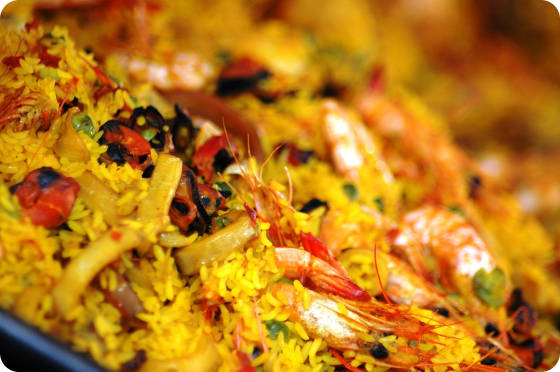
It’s easy to see how you could get hooked on paella, gazpacho, or tortillas de patata (Spanish omelet) and want to learn more about Spanish cuisine. Spanish food capitalizes on fresh ingredients and bold Mediterranean flavors to produce a unique yet approachable cuisine. Perhaps you’re not cooking at the level of elBulli (a small yet well-respected restaurant just outside of Roses, Cataloñia, Spain) yet, but that doesn’t mean you can’t jump into Spanish cuisine full throttle. Here are some ways to learn more about preparing Spanish food in order to expand your Iberian repertoire:
- Cook at Home – This might sound obvious, but cooking Spanish food at home in your own kitchen will give you the best feel for this cuisine. After all, Spanish food is known for being healthy and fresh—two things that can only come from home cooking. Blogs like My Kitchen in Spain and La Cocina de Nathan have a wealth of great recipes and general tips for cooking as if your kitchen were in the heart of Cataloñia. Before you get started, it’s a good idea to invest in some Spanish cooking essentials that you might not have on hand, like Spanish chorizo, saffron, piquillo peppers, ñora peppers, and olives.
- Take Nutrition Courses – Understanding healthy ratios of carbohydrates, protein, and fat will help you put together a more balanced and satisfying Spanish meal. University extension programs and community colleges both offer nutrition classes that can help you bone up on the principles of nutrition. These courses can also be useful for incorporating Spanish cooking into more restrictive diets, such as vegetarian or gluten-free diets. Take a class on foundational nutrition concepts to get started, if you’re unsure of the basics.
- Take Smaller Cooking Classes – While playing around in your own kitchen is one of the best ways to learn how to cook Spanish food, you don’t necessarily have to reinvent the wheel. Small, student-centered cooking classes can give you a jump start on the basic Spanish cooking techniques and provide some inspiration for your own cooking adventures. In classes with five or fewer students, you’ll be able to ask questions and get personal attention from your instructor.
- Visit Your Local Spanish Market or Grocery – If you live in an urban area, it’s likely that you have a Spanish grocery store or market in your area. These stores are usually staffed by Spanish individuals who are enthusiastic about Spanish cuisine and cooking. They can help you stock your pantry or suggest simple recipes to try. They can also help you decode the confusing but delicious selection of Spanish wines, to find a great pair for your meal.
- Pick a Region and Explore – Many Spanish dishes are cooked throughout the entire country. However, each region has their own spin on staples like soups, rice dishes, and seafood, and choosing one area to explore in-depth can focus your cooking forays.
